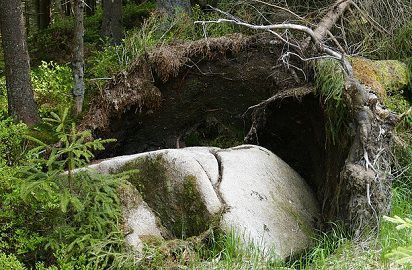The main root (primary root) with other minor side roots, which grow deep into the soil is called Taproot. While the fine, thick hairs like structure, that spread sideways in all the directions is called Fibrous or Adventitious root. Taproot arises from the radicle (embryonic part) of the plants, but the Fibrous root grows from the stem and leaves rather from the radicle.
Plants bear parts like stem, leaves, fruits, flowers and most importantly roots. Roots are the underground part, which helps in absorbing nutrients, water, and moisture from the soil. Most flowering plants, shrubs, and trees produce tap roots which can travel deep into the soil, while fibrous or adventitious roots are seen in grasses and reed (tall grasses) plants and grow near to the surface of the soil.
Content: Tap Root Vs Adventitious Root
Comparison Chart
| Basis for Comparison | Tap Root | Fibrous (Adventitious) Root |
|---|---|---|
| Meaning | Such roots which develop into primary root arising from radicle (embryonic root), these become the main root of the plant,with secondary, tertiary and other lateral branches. | Such roots that arise from other parts of the plants like stems, or leaves other than roots are called fibrous or adventitious root. |
| Develops from | It develops from the radicle of the embryo. | It develops from the stem, leaves or places other than radicle. |
| Features of root | Consist of a persistent primary root. | Consist of the short-lived root. |
| These are deep-rooted. | Usually shallow. | |
| Always underground. | Can be either underground or aerial. | |
| Taproot consists of only one long and main root. | Multiple root systems. | |
| It can be the surface feeder or deep feeder. | The root system of this type is the surface feeder. | |
| As compared to other roots main root is very thick. | Roots are thin, hair like, similar in thickness and are in the form of the cluster. | |
| Primary, secondary, tertiary and rootlets are visible. | No differentiation in roots and bunch of roots develops at one spot. | |
| Other characteristics | Can survive in the drought area. | Cannot survive in drought and will dry out easily, but quick in absorbing surface and irrigation water. |
| The tap root systems occur in dicots plants. | The fibrous or adventitious root system occurs in monocots. | |
| Leaves have reticulate venation. | Leaves have parallel venation. | |
| Example | Carrot, Reddish, Beets. | Onion, Grass, Wheat, Coconut palm. |
Definition of Tap Root
One of the main type of root system in angiosperms is the tap root systems. The roots which develop from the radicle (embryonic root) of the plants are called tap root. These are deep-rooted, underground roots having one main single thick root called as primary root. The primary root has branches as secondary, tertiary or lateral from the primary branch.
Taproot system is usually seen in dicots; these roots help plants to anchor better to the soil. It also helps in absorbing water from deeper sources, and hence these can survive in drought situation also.
In this type, the primary root originates directly from the embryonic root or radicle. This root grows in the downward direction into the soil. From this trunk shape primary root, lateral roots (roots that grow from the other root) develop initially in the horizontal direction and then turning downward.
These roots repeatedly develop into more finer roots, giving rise to a root tip, with a protective and minute root cap on the tip. This root cap helps in absorbing water and nutrients from the deep soil. The best examples are radish, carrots, and beets.
Definition of Fibrous (Adventitious) Root
Fibrous roots are known for the cluster or group of similarly sized, thickness, hair like structure. This structure emerges at the base of the plant, which can grow into the soil (downward) or aerially (upward) and in all the directions. Fibrous roots do not arise from the radicle but the other parts of the plants like stems and leaves.
Fibrous roots are helpful in controlling the soil erosion. This type is usually seen in monocots plants.
Key Differences Between Tap Root and Fibrous (Adventitious) Root
Given below are the substantial differences among two types of root system present in plants:
- Taproot system is usually seen in dicots, in this the roots arise from the radicle (embryonic root). These become the main root of the plant, with secondary, tertiary and other lateral branches visible. On the contrary in the adventitious or fibrous root system, there is no such primary root rather, even there are similarities in all roots. These are found in monocots plants. Fibrous root or adventitious root arise from the stem or leaves of a plant instead of the radicle.
- Taproot has many features like – These are deep-rooted, underground and persistent root. Taproot consists of the one, long main root, where secondary, tertiary and rootlets are visible. Even the primary root is very thick as compared to other roots (carrot, reddish). Whereas fibrous or adventitious roots contains short-lived roots, which are shallow and the growth can be either underground or aerial. These do not have primary roots; rather they have thin, hair like, roots, forming clusters and due to which there is no differentiation into main roots.
- The plants of tap root system may survive in the drought area and help in anchoring of the plants to the soil. Whereas plants with fibrous root or adventitious root system cannot survive in drought and will dry out easily, but are quick in absorbing surface and irrigation water.
- Leaves have reticulate venation of the plants having the tap root, while leaves having parallel venation comes under the adventitious or fibrous roots.
- Examples of plants with tap roots are carrot, reddish, beets, etc. On the other hand onion, grass, wheat, coconut palm are the examples of the fibrous roots or adventitious root system.
Similarities
- The main thing that keeps the plant alive is their source of nutrition, which further moves to the stem, leaves, flowers, and fruit through the vascular system. So the main similarity and function of the roots are to provide nutrition to the soil.
- It provides anchorage to the plants and thus holds the plants firmly with the soil.
- Food Storage.
Conclusion
Buried, unseen below the soil, plants roots are the most important part of the plants with the most vital function of providing nutrition, water to the plants. The roots exist in two forms which are tap root and fibrous or adventitious root. Some plants like carrots, reddish or beets have the tap root system while the grasses, wheat type have the fibrous root system.




Leave a Reply